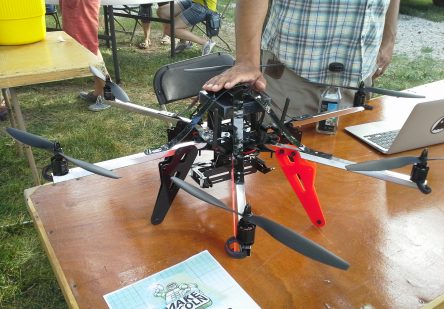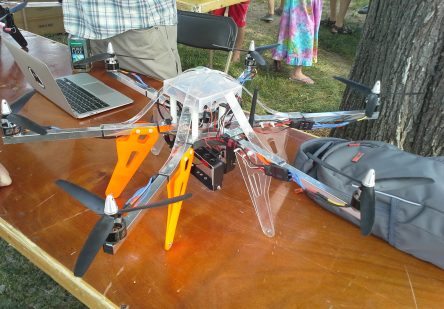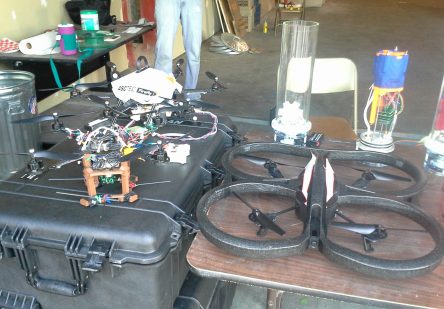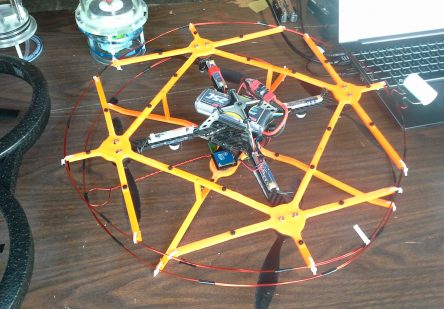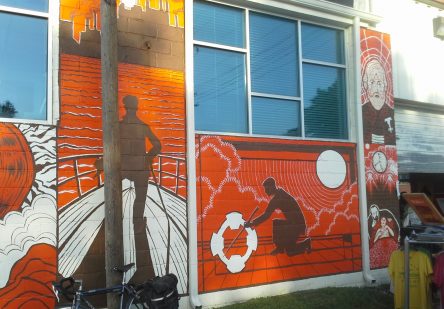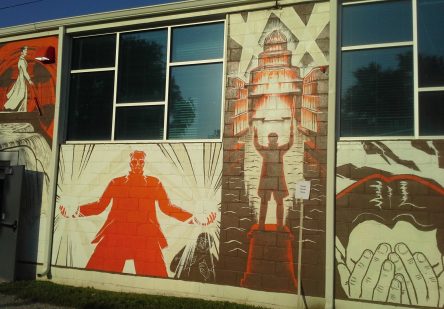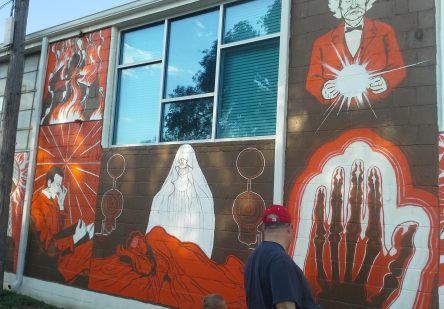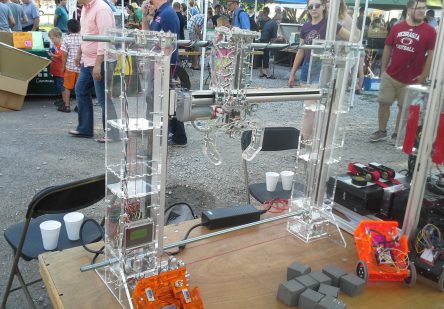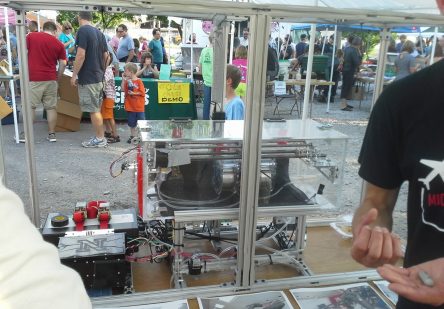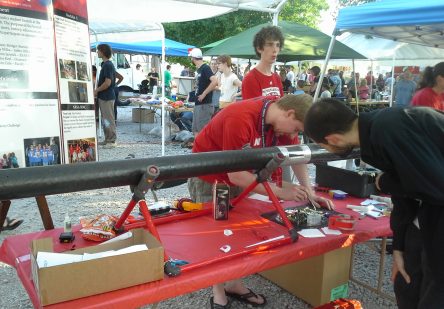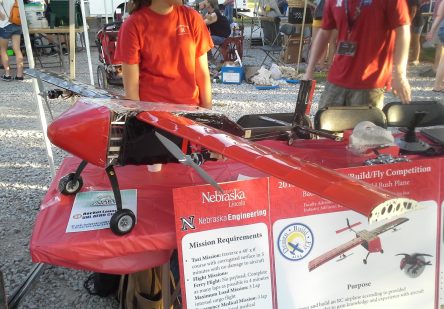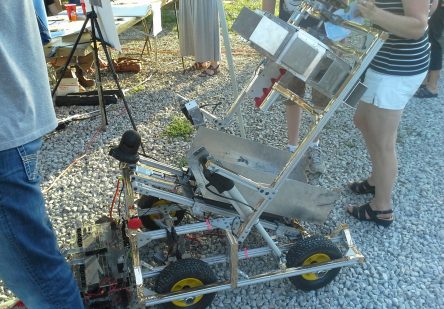Make Lincoln 2014
A few weeks ago I drove out to Lincoln to check out a local community event for Makers called MAKE LINCOLN 2014, and took a few photos to share what people brought. While it was not officially called a Maker Faire, many people I spoke with told me that it was essentially the same type of event. I suspect there may have been logistical or licensing issues that prevented it from being a “real” Maker Faire, but I didn’t personally speak with anyone at the event who was involved with the planning side.
Despite being in hosted in a relatively small parking lot in very hot, humid conditions, the turnout was really fantastic the entire time I was there. I would estimate maybe 50 or so exhibitors (anyone have a better guess?), most of which were outside under awnings. There was a pretty good mix of Makers, crafters and researchers, and even a few (very busy) food trucks. All of the ingredients of a good Maker Faire, just at a much smaller scale!
Compared to other Maker Faires I have attended there were many more craft vendors and researchers than hackers, open-source hardware people and artists. In fact, of the 4 or so aisles of booths, two were entirely made up of local craft people selling their wares and one was entirely made up of research students from the nearby academic engineering research powerhouse of the University of Nebraska at Lincoln. The final aisle was entirely made up of individuals showing off neat projects, who each seemed to represent a different group of overlapping grassroots Maker groups within Lincoln.
Notable projects, people and sights
I tried to take photos of all the Maker projects there (or at least the things that I liked) and didn’t document much of the craft vendors or research projects. Here are the things that stood out to me the most from the event:
Tethon3D ceramic 3D printing
 I was pleasantly surprised to see a small company from Omaha that I have been wanting to meet for some time. Tethon3D offers ceramic 3D printing for individuals, businesses and institutions at an extremely affordable rate. So affordable, in fact, that I will very likely be using them in the near future! Even cooler, I learned that they are based in the KANEKO studio, a very highly-respected gallery and studio space for a internationally acclaimed ceramic artist. Affordable ceramic 3D printing in a environment surrounded by talented artists? Sign me up!
I was pleasantly surprised to see a small company from Omaha that I have been wanting to meet for some time. Tethon3D offers ceramic 3D printing for individuals, businesses and institutions at an extremely affordable rate. So affordable, in fact, that I will very likely be using them in the near future! Even cooler, I learned that they are based in the KANEKO studio, a very highly-respected gallery and studio space for a internationally acclaimed ceramic artist. Affordable ceramic 3D printing in a environment surrounded by talented artists? Sign me up!
Hari Wiguna – 3D printing
 Hari is a Lincoln-based Maker who brought his home-made Printrbot and a bunch of great prints he produced with it. I was very impressed by Hari’s work and his approach to Making, and am looking forward to seeing what he comes up with next. I think it’s safe to say we both made a new Maker friend!
Hari is a Lincoln-based Maker who brought his home-made Printrbot and a bunch of great prints he produced with it. I was very impressed by Hari’s work and his approach to Making, and am looking forward to seeing what he comes up with next. I think it’s safe to say we both made a new Maker friend!
James Woody – Bluetooth temperature probe setup
 James is another Lincoln-based Maker who brought one of his active projects, a Bluetooth-accessible temperature monitoring system that uses an Arduino, some slick temperature probes and a custom-made Android app to allow the user the read temperatures in different locations remotely. Eventually this data can be used to actuate heating and cooling systems (or other electronic gizmos) automatically. Pretty sweet DIY project!
James is another Lincoln-based Maker who brought one of his active projects, a Bluetooth-accessible temperature monitoring system that uses an Arduino, some slick temperature probes and a custom-made Android app to allow the user the read temperatures in different locations remotely. Eventually this data can be used to actuate heating and cooling systems (or other electronic gizmos) automatically. Pretty sweet DIY project!
Lots of multirotor flying machines
For some reason there were a LOT of quadcoptors and multirotor machines at the event. I suspect it was indirectly due to the emphasis that UNL has on drone-based research and their Drone Journal Lab. Nonetheless, there were at least a half dozen to a dozen different copters at the event, some of which were being flown around for the crowd.
Epic mural on the Turbine Flats building
On the side of the building that this event was hosted at was a really fantastic mural depicting (I believe) the personal journey of Nikola Tesla as he traveled to the states, worked for George Westinghouse, lit up the 1893 Chicago World Fair, battled Edison in the War of Currents and more. I really enjoyed seeing this in person!
UNL research booths
I remember being very impressed with the projects presented by the research students from UNL, but also being somewhat frustrated when student after student told me that they couldn’t share too much of their project because of various patents and pending research publications. For me, Maker Faires are generally intrinsically connected to the open-source hardware community, and Makers are usually very eager to explain how they made the things they are showing. But to me, it felt like the researchers didn’t really expect to answer questions about their workflows and fabrication processes, just about their grants and the fun aspects of their research.
However, what I did learn from talking to the researchers was just how much different their workflows are from typical hobbyists and other Makers. For example, when I asked how they made their circuit boards, they all said they weren’t sure, but they paid a company a few hundred to a few thousand dollars to fabricate and assemble the boards for them (usually for only one board at a time!). I also asked about how they produced some of their metal components, and was told that they just send the work to a local machine shop and pay a few thousand dollars to have them fabricate it for them from their design files.
One of the most bizarre projects I saw from the researchers was a simple mechanism that holds a pig’s intestine within a plexiglass cage as part of a NASA grant. The rig was built entirely out of aluminum extrusion, and contained several hundred dollars worth of electronics just to pull the intestine apart at different distances. It was the kind of thing that I would expect to see in a contemporary new media art gallery, but was instead being used to test how well a patented magical pill they made would be able to travel through intestines in low-gravity environments. They actually took the thing up in a reduced gravity aircraft and took data in low-gravity. Which means that they spent tens of thousands of dollars to see if a little pill would travel through a pig’s intestine in low-gravity. Wow!
As impressive as this work all was, on the drive back home I couldn’t shake the feeling that the event was almost like an advertisement for UNL and their upcoming maker building. I am told that there is a very, very large Maker Club at UNL (estimates of several hundred people in attendance), but there is very little information available online about it. Nonetheless, there were posters and flyers all about how UNL is building a gigantic new facility that combines large shop space with on-site entrepreneur support. Should be interesting to see, but would sure love to see more information about it available to the public!
All pictures from the event
[flickr-gallery mode=”photoset” photoset=”72157645646795785″]
